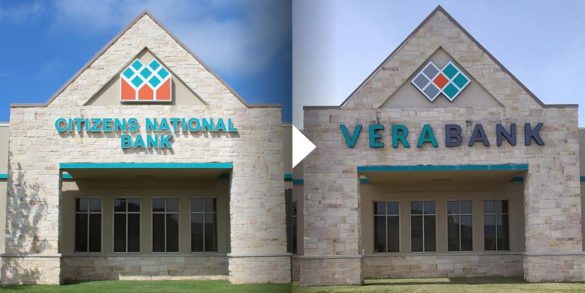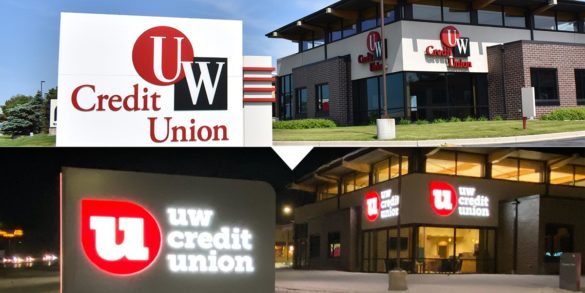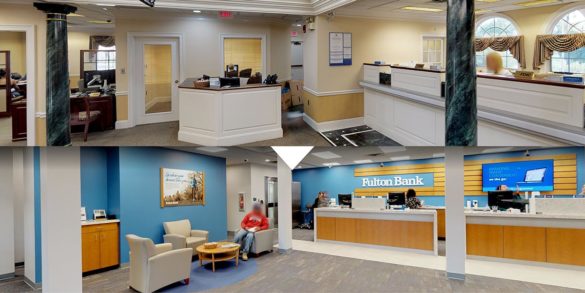Rebranding branches acquired in a merger or acquisition involves much more than simply changing the logo on the outside of the building. Costs, culture change, and consistency across the branch network must all be addressed. Otherwise a bank or credit union not only risks wasting time and money, but, far worse, disaffecting staff and ultimately losing customers.
Even in an era when customers handle most of their banking transactions online, for the vast majority of banks and credit unions the branch remains crucial to attract, interact, and, yes, even to transact with some customers. When an acquired branch suddenly switches from one form that customers were comfortable with to a new look and feel, how that transformation occurs could mean the difference between keeping or losing business.
“You should not underestimate the importance of your branch experience today even as transactions migrate out,” says Gina Bleedorn, Chief Experience Officer at Adrenaline, an experience design agency, in an interview with The Financial Brand.
What’s at Stake:
Interactions in branches now have a heightened importance and value. They help shape experience and guide consultative selling.
Three factors will govern the process of rebranding merged or acquired branches. Affordability will govern much of what can be done, so that should be considered first.
Read More: 5 Ways to Make Sure Your Rebranding Project Doesn’t Fizzle
1. How Much Are We Willing to Invest?
First step in planning a post-merger branch rebranding is the realistic assessment and acceptance of the costs involved. It’s easy to underestimate the costs, says Bleedorn, because such combinations affect everything, including the size of the branch network, planning and redesign, staffing, marketing and continuous communications.

Why Industry Cloud for Banking?
PwC’s Industry Cloud for Banking helps deliver personalized products and services that today’s customers expect.

Navigating Credit Card Issuing in an Uncertain Economic Environment
Build a modern credit card strategy that balances profitability and risk, adopts the latest technology and delivers the customization that cardholders demand.
Read More about Navigating Credit Card Issuing in an Uncertain Economic Environment
First Horizon Bank, based in Memphis, Tenn., is in the process of rebranding former Iberiabank branches throughout multiple states, ultimately establishing a network of some 500 branches. “What’s most important is how do we create the First Horizon brand within Iberiabank locations at the most reasonable cost, but also do it in a manner that we don’t cut corners so much that we miss some areas that are important,” says Peter Powell, retail strategy and delivery, distribution, planning, and transformation leader at First Horizon.
Merger rebranding is a complex process because not every branch is created equal, observes Frank Beardsworth, Managing Director at Adrenaline. “It doesn’t help to put a new program in place in a very tired and dingy looking branch,” he says. Also, based on local market analytics, it may make sense to put more money and resources into branches that have greater business potential.
Read More: How To Tackle The Big Rebranding Challenges In Banking
As a very general rule of thumb, Beardsworth says that after an institution does site surveys and interviews with branch personnel, branches can be sorted in three distinct classes, each with a different budget range:
- A rebranding and physical retrofit budget for a branch with very favorable market analytics showing the most growth potential would range from $100,000 to $110,000.
- A middle-tier branch where there might be some opportunities to sell the brand, a budget might range between $50,000 to $80,000.
- At the lower end, where a branch for various reasons might just need a basic upgrade, the budget might range from $30,000 to $50,000.
2. Follow an Outside-Inside Strategy
The goal of a branch rebrand should be taking the best parts of the acquired branch experience and incorporating them with the best parts of the acquiring institution to make the customer experience even better than it was before. The acquired branches should blend consistently into the overall brand of the acquiring institution, and at the same time keep some of the individuality that the branch has established over its history.
“Your branch exterior is your beacon. It’s your face. But your interior is your experience.”
— Gina Bleedorn, Adrenaline Agency
“We want to be respectful to both legacy brands along the way,” Powell says. “Maintaining aspects of the overall banking center design that clients value is extremely important to us. The priorities include the application of First Horizon elements that we’ve used previously but also making sure we’re honoring where we’ve been in the past while looking to the future with the two organizations combined into one.”
An effective branch rebranding requires an outside-inside strategy. “Your branch exterior is your beacon. It’s your advertising. It’s your face forward to the community and it is your reason to attract anyone,” Bleedorn says. “But your interior is your experience. That’s where your bankers are actually interacting with people.”
Outside starts with the new logo as well as new corporate colors. Also, attention has to be paid to other exterior touchpoints, including ATMs, merchandising material, and even such things as the bollards that lead up to the drive-in window. (These posts might be spruced up with corporate colors or even cleverly constructed merchandising information.)
Inside, however, is where the transformation gets really specific. Adrenaline estimates there could be up to 45 different customer-facing elements in a given branch that need to be taken into the new corporate brand.
These range from wall color, carpet designs, teller station backgrounds, digital displays, and even such things as the area where required compliance documents are presented. Different areas inside the branch need to be delineated, such as where business is transacted, where consultation takes place and where basic interaction occurs, such as waiting areas or entrance ways.
Simultaneously each branch should exhibit some sort of individuality or even continuity. This can be done several ways, such as displaying iconic photographs of the community or events that occur nearby. Peter Powell notes that some First Horizon branches have longstanding relationships with local artists or art schools and offer space for their work.

Most important, the banker says, is to allay current customers’ concerns about the continuation of service after the rebranding effort. “Their first concerns are about their banker,” he says. “An important understanding for our clients is even though a brand may change, even though the colors may change, even though the name may change on the door, our bankers will still be there.”
Read More: Trends in Branch Design From Banks and Credit Unions Around The World
3. Get Everybody Onboard
Not only do customers need to accept the physical aspects of the new brand, the staff inside the branch — who are the personification of the new brand — need to understand what it is about, know what their status is within the new regime, and have a sense of ownership of what is hoped to be a new and better place to be.
“If the merger is not truly understood by your people you risk not only attrition of staff but loss of customers,” Bleedorn says.
Unintended Consequence:
If staff doesn’t have a full understanding of what the merger means for them and why it’s a good thing, that ambiguity will be conveyed to customers.
There’s no such thing as over-communication with staff, says Powell. In the time since the First Horizon-Iberiabank merger was announced, various two-way email chains were set up, many department “huddles” have occurred where executives coordinate within their areas, and a bank-wide online newsletter relates all things merger to everyone.
Ultimately “you want staff to have the answer before the client asks a question,” says Powell.










